Table of Contents
Bedtime can be tough for parents and kids. Studies show 70% of parents feel rushed, causing stress. But, with creative bedtime routines, that include sleep activities for kids, it can become a special bonding time.
Children aged 3-5 need structured bedtime experiences. In fact, 60% of young kids already have bedtime routines like reading or stories. Adding fun sleep activities can greatly improve their sleep and mood.
Interactive bedtime activities are very beneficial. They can cut down the time it takes to fall asleep by up to 30%. Families who add fun to their bedtime see a 50% boost in their kids’ sleep quality. It makes bedtime a time for connection and growth.
The secret to great bedtime routines is being creative and consistent. Role-playing can boost social skills by 40%, and calming games can lower anxiety by 20%. These activities not only help with sleep but also strengthen the bond between parents and kids.
Parents looking to change bedtime will find that engaging sleep activities can make it a special daily ritual. With the right approach, bedtime becomes a time for learning, bonding, and peaceful sleep.
1 Understanding the Importance of Bedtime Routines
Sleep is key for kids’ growth, affecting their behavior and learning. Parents who know how bedtime schedules work can boost their kids’ health and school success.
[lasso id=”37″ link_id=”518″ type=”table”]

Studies show sleep’s big impact on kids’ daily life. Kids who don’t sleep enough might seem like they have ADHD. They could have trouble focusing and get easily distracted.
The Science Behind Sleep and Child Development
Sleep is not just a rest. It’s crucial for brain growth. Each age group needs different amounts of sleep:
- Infants (0-12 months): 14-15 hours of sleep
- Toddlers (1-3 years): 12-14 hours of sleep
- Preschoolers (3-5 years): 11-13 hours of sleep
- School-age children (5-12 years): 10-12 hours of sleep
Benefits of Consistent Bedtime Schedules
Setting up regular bedtime routines has many benefits for kids. Parents who make sleep times predictable help their children:
- Learn to control themselves better
- Manage their feelings better
- Think more clearly
- Have fewer tantrums and behavior problems
“A solid bedtime routine may reduce tantrums and behavioral issues in children.” – Sleep Research Institute
Impact on Behavior and Learning
Good sleep helps kids do well in school and get along with others. Studies show kids who sleep enough do better in school and have fewer behavior problems.
Experts suggest starting bedtime routines 30-60 minutes before sleep. Make the room calm and avoid screens before bed.
2 Why Traditional Bedtime Approaches Often Fail

Bedtime can be tough for many parents. Traditional methods often don’t work well. Only 30% of parents consistently put their children to bed at the same time each night. This shows how hard it is to find effective sleep strategies.
Parents sometimes use methods that make bedtime harder:
- Using bribery as a temporary solution
- Inconsistent rule enforcement
- Negotiating with children instead of establishing clear boundaries
- Changing routines frequently
“The key to successful bedtime routines is consistency and understanding your child’s unique needs.”
Studies show how complex bedtime challenges are. A study of 185 parents with children ages 3 to 7 years found big differences in bedtime routines. Notably, only 25% of parents reported reading to their children every night. This is important for a calming pre-sleep ritual.
[lasso id=”38″ link_id=”519″ type=”table”]
Not knowing about children’s sleep needs can lead to bad strategies. Different ages need different amounts of sleep:
- 1-3 years: 12-14 hours of sleep
- 3-6 years: 10-12 hours of sleep
- 7-12 years: 10-11 hours of sleep
Parents need to know that being too strict or not consistent can make things worse. The best bedtime routines are predictable, calm, and fit each child’s needs.
3 Creative Bedtime Routines: Fun Sleep Activities for Kids and Healthy Sleep Habits
Creating the perfect bedtime routine can make bedtime fun and relaxing for kids. It’s about finding activities that fit their age and help them sleep well.

Sleep is very important for kids’ growth. Most kids need 10 to 11 hours of sleep each night. Kids aged 5 to 12 need 9 to 11 hours to feel fresh and ready to learn.
Age-Appropriate Bedtime Activities
Each age group needs different bedtime activities:
- Toddlers (2-3 years): Short, predictable routines with gentle activities
- Preschoolers (4-5 years): Interactive storytelling and simple relaxation games
- School-age children (6-12 years): More complex calming activities and independent wind-down time
[lasso id=”39″ link_id=”520″ type=”table”]
Calming vs. Energizing Activities
It’s important to know the difference between calming and energizing activities for bedtime.
| Calming Activities | Energizing Activities |
|---|---|
| Soft music | Active play |
| Gentle stretching | Competitive games |
| Quiet reading | Exciting storytelling |
Time Management Tips
Good bedtime routines need planning. Here are some tips:
- Create a consistent 30-minute wind-down period
- Use visual schedules for younger children
- Limit screen time at least one hour before bed
- Prepare materials for activities in advance
*”A well-planned bedtime routine can reduce resistance and increase sleep quality for both children and parents.”*
Studies show that regular bedtime routines can improve sleep quality by up to 30% for kids. By choosing the right activities and managing time well, parents can make bedtime peaceful and support healthy sleep habits.
4 Interactive Storytelling and Imagination Games

Bedtime stories turn regular nights into magical adventures. They spark kids’ creativity and imagination. Interactive storytelling makes reading more than just reading. It invites families to create exciting stories together.
Imagination games make bedtime exciting. They help kids grow their creativity. Studies show that interactive stories can boost language skills by up to 50%.
- Create stories where family members become characters
- Use interactive prompts to develop narrative together
- Encourage children to contribute plot twists
- Build storytelling around personal experiences
[lasso id=”1861″ link_id=”521″ ref=”amzn-campfire-stories-deck-for-kids-storytelling-games-to-ignite-imagination”]
*”Storytelling is the most powerful way to put ideas into the world.”* – Robert McKee
Snorble shows how bedtime stories can help kids grow. They mix play and stories, helping kids learn while winding down for sleep.
Imagination games should be calm and soothing. Avoid stories that are too exciting. Instead, aim for a peaceful setting that helps kids sleep.
Adding interactive stories to bedtime routines can make it special. It becomes a time for connection and creativity with your family.
5 Movement and Relaxation Activities
Getting kids ready for bed is more than just putting them in bed. Gentle activities can make bedtime easier. Kids yoga, breathing exercises, and stretching games help kids relax and sleep better.
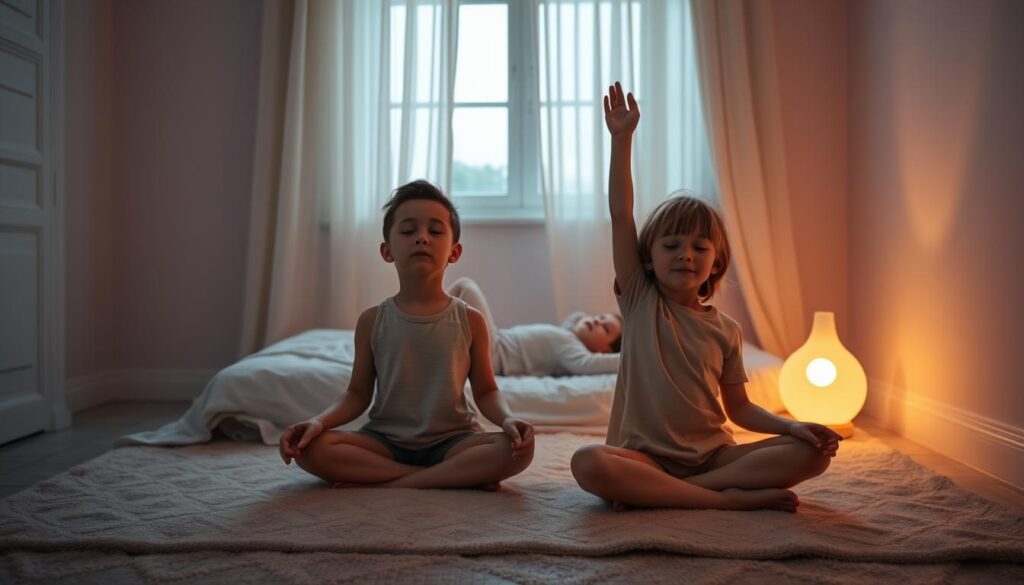
Children often feel anxious at night, with 3:00 AM being a common wake-up time. Using relaxation techniques can greatly improve their sleep and reduce stress.
Gentle Yoga for Kids
Kids yoga is great for releasing tension and stress. Simple poses help calm their bodies and minds before bed:
- Child’s Pose: Mimics a resting position that feels safe and comforting
- Butterfly Stretch: Helps open hips and promotes relaxation
- Seated Forward Bend: Encourages gentle stretching and deep breathing
[lasso id=”1862″ link_id=”522″ ref=”amzn-yoga-for-kids-outer-space-blastoff”]
Breathing Exercises
Breathing exercises activate the parasympathetic nervous system. Birthday candle breaths are a fun way to teach kids to relax:
- Imagine blowing out birthday candles slowly
- Inhale deeply through the nose
- Exhale gently, as if extinguishing candles
[lasso id=”1863″ link_id=”523″ ref=”amzn-breathing-pal-ted-mindfulness-breathing-light-guided-visual-meditation-breathing-light-anxiety-relief-items-for-calm-down-corner-meditation-sleep-for-adultkid”]
Research suggests children need about one minute of meditation for each year of their age to calm down.
Stretching Games
Turning stretching into games makes it fun for kids. Stretching games prepare the body for sleep and bond parents and kids.
By adding these activities to bedtime, parents can make a calming routine. This helps kids smoothly transition to a peaceful night’s sleep.
6 Music and Sound-Based Sleep Activities

Sound-based sleep activities can make bedtime easier. Research shows that music and sounds can improve sleep for kids and adults. This can turn bedtime into a calm moment.
Bedtime music is a great way to relax the environment. Sleep experts say the right sounds can cut down on time it takes to fall asleep. They also make sleep more efficient.
[lasso id=”1864″ link_id=”524″ ref=”amzn-yogasleep-baby-soundscene-white-noise-sound-machine-20-relaxing-sounds-lullabies-starry-night-light-projector-bedroom-decor-for-infant-toddler-kids-noise-canceling-sleep-aid-registry-gift”]
“Music can be a magical bridge between wakefulness and restful sleep” – Sleep Wellness Institute
Effective Sound-Based Sleep Strategies
- Lullabies with gentle, repetitive melodies
- White noise machines mimicking natural sounds
- Soft instrumental music
- Nature sound recordings
- Guided meditation audio tracks
The Listening Program by Alex Doman shows how sound can calm the body. Studies say certain music can relax the body. This helps kids fall asleep easier.
Choosing the Right Sounds
When picking bedtime music, think about these things:
- Tempo: Slower rhythms help you relax
- Volume: Sounds should be soft and quiet
- Consistency: Use the same sounds every night
- Child’s preferences: Let them help choose
Sound-based sleep activities can lower stress and heart rate. They create a calming routine before bed. By using music wisely, parents can help kids sleep better.
7 Art and Creative Expression Before Bed
Bedtime art activities are a magical way to help kids relax before sleep. They help kids manage their feelings and make bedtime a special time.

Studies show that art therapy is great for kids’ sleep and feelings. Just 20-30 minutes of calming activities like coloring can make a big difference.
Calming Coloring Activities
Coloring is a calming way to get ready for bed. Kids can try different things to make their bedtime routine soothing:
- Choose coloring books with soft designs
- Use soft pencils or watercolor crayons
- Make a cozy coloring area with comfy chairs
- Listen to soft music while coloring
[lasso id=”1865″ link_id=”525″ ref=”amzn-hopscotch-girls-i-am-confident-brave-beautiful-inspirational-coloring-books-for-kids-ages-4-8-up-8-12-empowering-boost-confidence-color-book”]
Art is not just an activity, but a pathway to inner peace and emotional understanding.
Children’s Journaling
Journaling is another great way for kids to express themselves and process their day. It helps them calm down and get ready for sleep.
| Journaling Technique | Benefits |
|---|---|
| Gratitude Journaling | Promotes positive thinking and emotional well-being |
| Dream Visualization | Encourages imagination and reduces bedtime anxiety |
| Feelings Tracking | Helps children understand and manage emotions |
Adding bedtime art to your evening routine makes for a peaceful sleep transition. These activities calm the mind and help kids grow emotionally and connect with others.
8 Building Connection Through Bedtime Activities

Bedtime is a special time for parents and kids to bond. It’s not just about getting ready for sleep. In fact, 95% of parents who talk about the day’s highlights see better bedtime behavior. This creates a chance for closeness and understanding.
To build a strong bond at bedtime, parents need to use special strategies. Here are some effective ways:
- Share favorite moments from the day
- Express genuine gratitude for each other
- Practice gentle physical affection
- Engage in quiet conversations
Bedtime connection does more than just comfort. Studies show that regular bedtime routines can boost parent-child attachment by about 25%. This bond helps kids feel less anxious and more secure.
“The most important time to connect with your child is often the quietest moment of the day.” – Child Development Expert
Children who have positive bedtime moments grow emotionally stronger. Just 10-15 minutes of quality time can make a big difference. It helps parents and kids create lasting memories and a stronger bond.
| Bedtime Connection Activity | Emotional Benefits |
|---|---|
| Storytelling | Reduces anxiety, improves communication |
| Gratitude sharing | Enhances positive emotional awareness |
| Gentle physical touch | Increases sense of security and love |
The aim is not to be perfect but to be consistent and loving. This makes your child feel valued and understood during these special moments.
9 Role-Playing and Dramatic Play at Bedtime
Bedtime role-play turns sleep time into a fun adventure for kids. It lets them use their imagination and get ready for bed. Parents can make bedtime fun and teach their kids through creative stories.
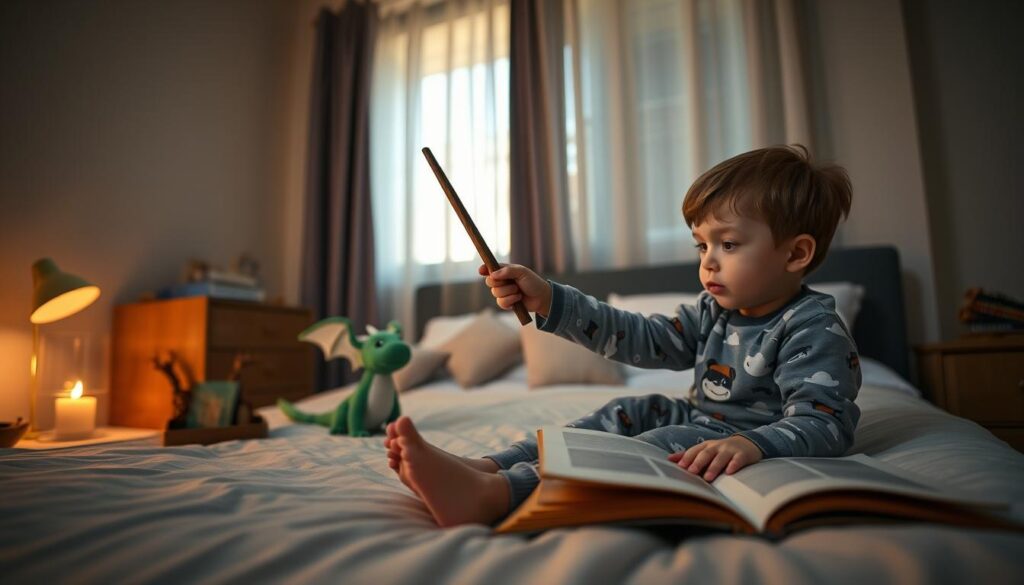
Children love to imagine and it helps them deal with their feelings. Bedtime role-play is great for their emotional growth and helps them sleep better.
[lasso id=”1866″ link_id=”526″ ref=”amzn-5-little-monkeys-finger-puppets-for-kids-7-pack-plush-finger-puppets-toy-storytelling-theater-role-play-bedtime-story-for-toddlers”]
Character Creation Strategies
Creating characters can make bedtime play more fun and meaningful. Here are some tips:
- Use characters from favorite books or movies
- Create new characters based on your child’s likes
- Let your child help make the characters
- Make sure the characters are safe and right for their age
Storytelling Techniques
Bedtime stories need to be creative and gentle. Here are some good ways to do it:
| Technique | Description | Benefits |
|---|---|---|
| Collaborative Storytelling | Take turns adding to the story | Keeps kids interested |
| Emotional Narrative | Include feelings and solving problems | Helps with emotional understanding |
| Calming Scenarios | Make the story calm and soothing | Helps kids relax |
“Imagination is more important than knowledge.” – Albert Einstein
Adding bedtime role-play to your routine makes bedtime magical. It helps kids relax and boosts their creativity and emotional skills.
10 Sensory Activities for Better Sleep

Sensory bedtime activities are key for kids to sleep well. About 30% of children struggle with sleep. This makes sleep-promoting sensory play vital for parents.
A multi-sensory environment can greatly improve sleep. Calming sensory experiences engage the body’s relaxation response. This helps kids relax better.
“Sensory activities are like a gentle lullaby for the nervous system” – Pediatric Sleep Specialist
Effective Sensory Bedtime Strategies
- Lavender essential oil diffusion
- Gentle massage techniques
- Weighted blanket use
- Soft, textured comfort objects
- Dim, warm lighting
Studies show sensory activities can cut sleep start time by 40%. Parents can make bedtime calm and predictable with the right sensory steps.
| Sensory Activity | Sleep Improvement Potential |
|---|---|
| Essential Oil Aromatherapy | 30% Enhanced Sleep Quality |
| Deep Pressure Stimulation | 25% Faster Sleep Onset |
| Calming Music | 35% Reduced Nighttime Awakenings |
By adding thoughtful sensory bedtime activities, parents can make a peaceful sleep space. This supports their child’s natural sleep and helps them sleep well.
11 Creating a Sleep-Friendly Environment
Making a sleep-friendly bedroom for kids is key for good rest and growth. A well-thought-out bedroom can make bedtime easier and more relaxing.

The right sleep space greatly affects how well kids sleep. Parents should pay attention to a few important things to make the best sleep area.
Lighting Considerations
Lighting is very important for sleep prep. Soft, dim lights tell the brain it’s time to sleep. Here are some tips:
- Use blackout curtains to block out outside light
- Install dimmer switches for easier light control
- Choose warm, low-intensity night lights
Temperature and Comfort Optimization
Temperature greatly affects sleep quality. Keeping the room cool and comfy is essential for a good night’s sleep.
| Age Group | Recommended Room Temperature | Ideal Bedding |
|---|---|---|
| Toddlers | 68-72°F | Light, breathable blankets |
| School-Age Children | 65-70°F | Layered bedding options |
| Teenagers | 60-67°F | Adjustable comforters |
[lasso id=”1654″ link_id=”527″ ref=”amzn-luna-luxe-cotton-weighted-blankets-for-kids-adults-100-oeko-tex-cotton-weighted-blanket-soft-comfortable-breathable-travel-blanket-all-season-winter-premium-gift-ideas”]
Sound Management Strategies
Noise can really mess with a child’s sleep. White noise machines or soft sounds can help make a calm, steady sound environment.
“A quiet, peaceful bedroom is the foundation of restful sleep for children.” – Sleep Research Institute
By using these strategies, parents can make a cozy bedroom that helps kids sleep better and stay healthy.
12 Managing Bedtime Resistance and Anxiety
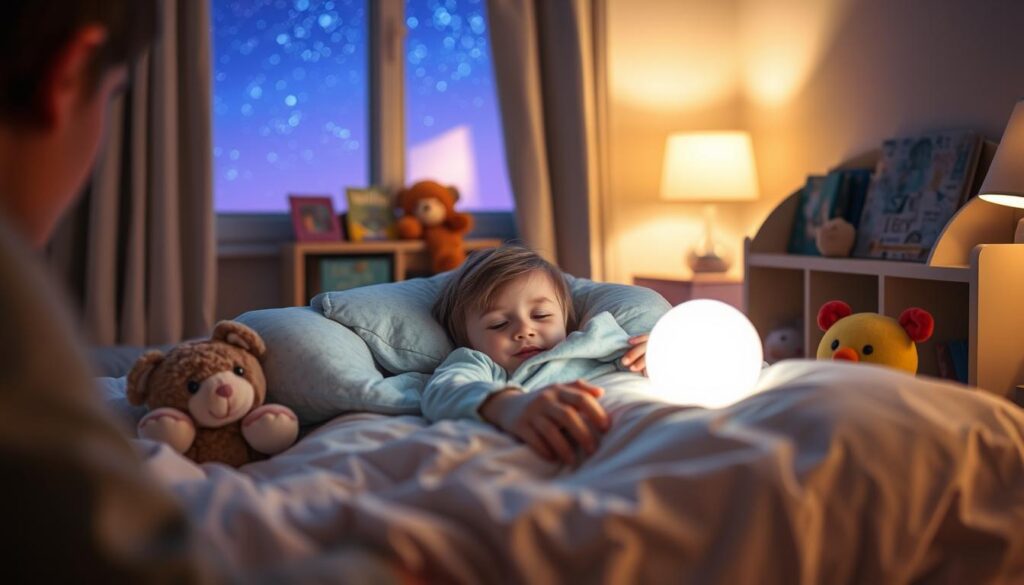
Bedtime anxiety is a common issue for many parents. Knowing what causes it helps families find ways to help their kids sleep better. This includes creating a calm bedtime routine.
“Sleep is the golden chain that binds health and our bodies together.” – Thomas Dekker
Children have many feelings that can make bedtime hard. It’s important for parents to know what these feelings are. This way, they can help their child feel better and sleep well.
- Separation anxiety affects over 20% of children
- Fear of the dark or imaginary threats can cause sleep resistance
- Overstimulation from daily activities may increase nighttime stress
To manage bedtime anxiety, start with a regular routine and a calm place. Studies show kids sleep better and wake up less if they have a set bedtime routine.
| Anxiety Trigger | Recommended Solution |
|---|---|
| Separation Concerns | Gradual reassurance and comfort objects |
| Fear of Darkness | Soft night lights and calming music |
| Overstimulation | Reduced screen time before bed |
Parents can help kids by starting predictable and soothing bedtime rituals. A routine like bath, massage, reading, and a lullaby can take 30-45 minutes. It makes kids feel safe and secure.
- Create a consistent sleep schedule
- Practice relaxation techniques
- Address underlying emotional needs
- Limit electronic device usage before bedtime
If bedtime struggles last, talk to a pediatrician. They can offer advice tailored to your child’s needs. This can help solve sleep problems.
13 Technology-Free Bedtime Activities
Finding screen-free bedtime routines can be tough for parents. Studies show that too much tech can mess with sleep, even for kids. The blue light from screens can make it tough for them to relax and sleep.
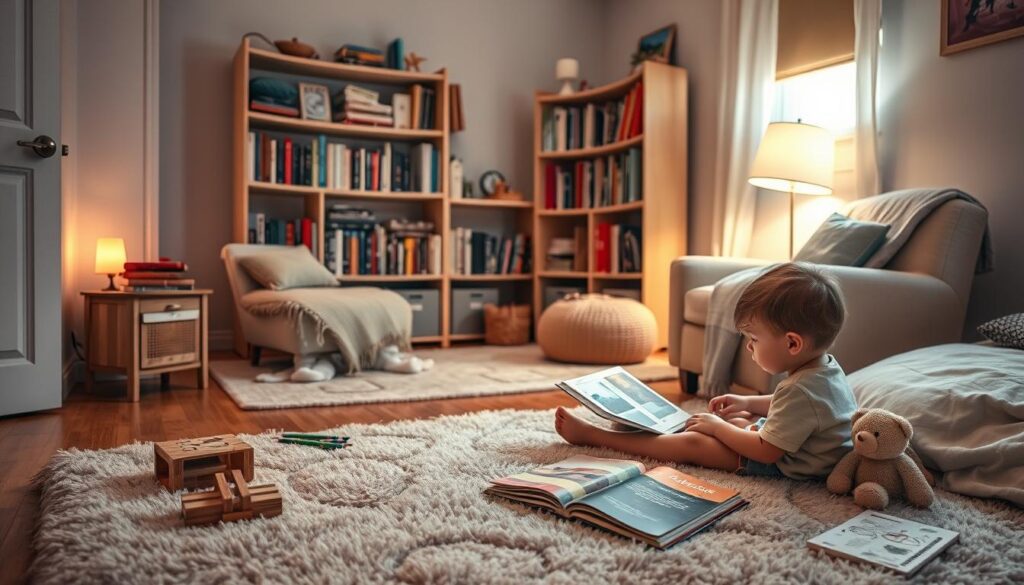
Switching to non-digital activities can make bedtime better. Kids who don’t use tech before bed sleep better and bond more with their families.
Screen-Free Alternatives for Evening Relaxation
- Storytelling without digital devices
- Board games that encourage interaction
- Quiet drawing or coloring activities
- Simple musical instruments
- Gentle stretching or relaxation exercises
Traditional Games and Puzzles
Traditional games are a great choice for bedtime. They’re fun and help kids think better and solve problems.
| Game Type | Benefits | Recommended Age |
|---|---|---|
| Jigsaw Puzzles | Improves cognitive skills, patience | 5-12 years |
| Card Games | Enhances strategic thinking | 7-14 years |
| Memory Games | Boosts concentration | 4-10 years |
“Unplugged play leads to deeper connections and more meaningful interactions between parents and children.” – Sleep Research Institute
[lasso id=”1868″ link_id=”528″ ref=”amzn-ry-wooden-puzzles-for-kids-ages-4-6-6-packs-60-pcs-jigsaw-puzzles-preschool-educational-toys-gifts-for-children-ages-4-8-kids-puzzles-for-4-year-olds-boys-girls-wood-puzzles-ages-3-4-5-6-7-8″]
Choosing screen-free activities for bedtime can make family time better. It helps kids sleep well, strengthens family bonds, and boosts their thinking skills.
14 Special Occasions and Bedtime Celebrations
Creating special bedtime routines can turn ordinary nights into unforgettable moments for kids. Celebrating milestones at bedtime helps strengthen family bonds and makes sleep time fun.

Parents can add unique traditions to make bedtime special without hurting sleep habits. These celebrations mark important moments, like losing a first tooth or reaching a goal.
- Create a monthly milestone chart
- Design special celebration pajamas
- Introduce a reward system for consistent bedtime routines
“Bedtime celebrations are about creating magical moments that children will remember forever.”
Special bedtime routines have a big impact:
| Celebration Type | Family Participation |
|---|---|
| Holiday Pajama Traditions | 52% |
| Advent Calendar Usage | 54% |
| New Stuffed Animal Introductions | 40% |
Here are some new ideas for bedtime celebrations:
- Gratitude Sharing: Kids who say thanks often are 20% happier
- Create seasonal storytelling nights
- Design personalized bedtime reward charts
By adding these special bedtime routines, families can make sleep time a cherished moment. Kids will look forward to it every night.
15 Adjusting Routines for Multiple Children
Managing bedtime for siblings is like leading a complex orchestra. Parents with many kids face the challenge of creating a peaceful night routine for each child. This routine must meet each child’s unique needs.
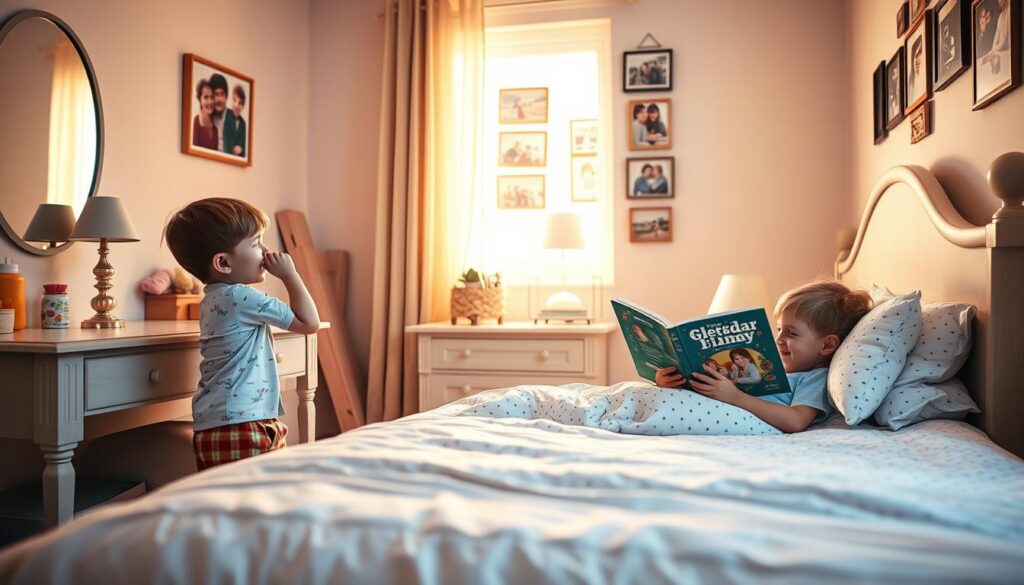
Successfully managing bedtime for multiple kids requires careful planning and being flexible. Studies show that 70% of parents struggle with coordinating bedtime routines. But, with the right strategies, bedtime can become a calm and peaceful time.
- Prepare nighttime essentials in advance
- Create age-appropriate individual routines
- Involve older siblings in helping younger ones
- Establish consistent timing and expectations
“The key to managing multiple bedtimes is creating a structured yet flexible approach that respects each child’s unique needs.” – Pediatric Sleep Specialist
For families with kids of different ages, having a synchronized bedtime routine is key. Here are some practical tips:
| Child Age | Bedtime Strategy | Duration |
|---|---|---|
| 6 months | Feeding and gentle bedtime routine | 20-30 minutes |
| 18 months | Short bedtime story and cuddle time | 15-20 minutes |
| 3 years | Extended storytelling and independent wind-down | 30-40 minutes |
Getting older siblings involved in bedtime can make them feel responsible. It also helps younger kids feel more at ease. For example, a 3-year-old can read stories to their younger siblings. This creates a supportive family atmosphere.
Research shows that 60% of kids do better with a set sleep schedule. By sticking to routines and getting everyone involved, parents can turn bedtime into a special family time.
16 Conclusion
Creating fun bedtime routines changes the night for families. Bedtime strategies are key for a child’s growth and happiness. They help meet the sleep needs of kids at every age.
Getting kids to sleep well takes time, patience, and creativity. About 25% of kids struggle with sleep. So, it’s important to make bedtime routines that are comforting and predictable.
Activities like yoga and stories can make bedtime special. Each one helps kids relax and get ready for sleep. It’s all about finding what works best for each child.
Bedtime is a chance for parents to bond and teach. By trying different things and listening to their kids, families can make bedtime peaceful. This helps kids grow in many ways.
Putting effort into bedtime routines really helps kids. Start with small steps, stay consistent, and enjoy the calm nights that follow.










